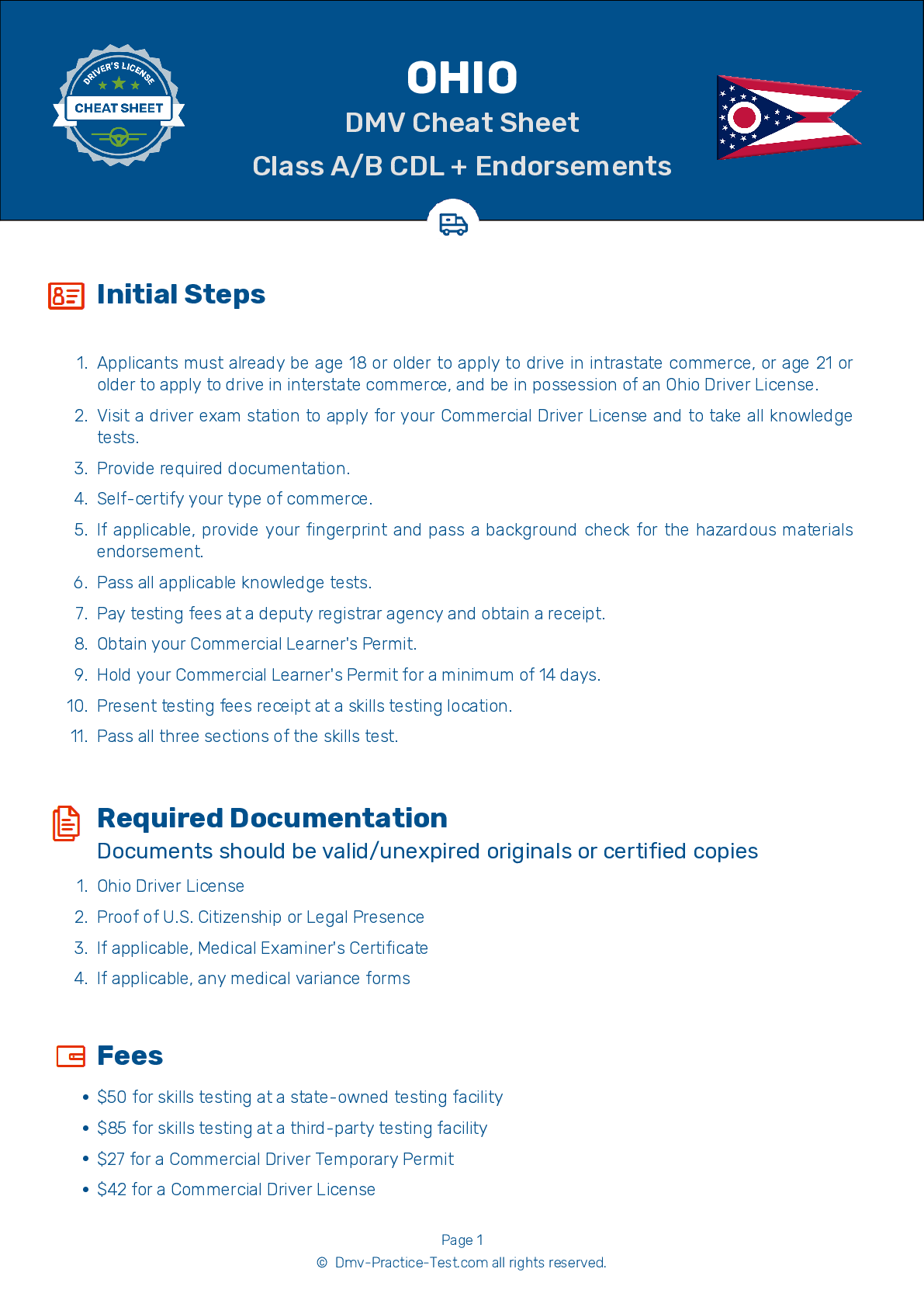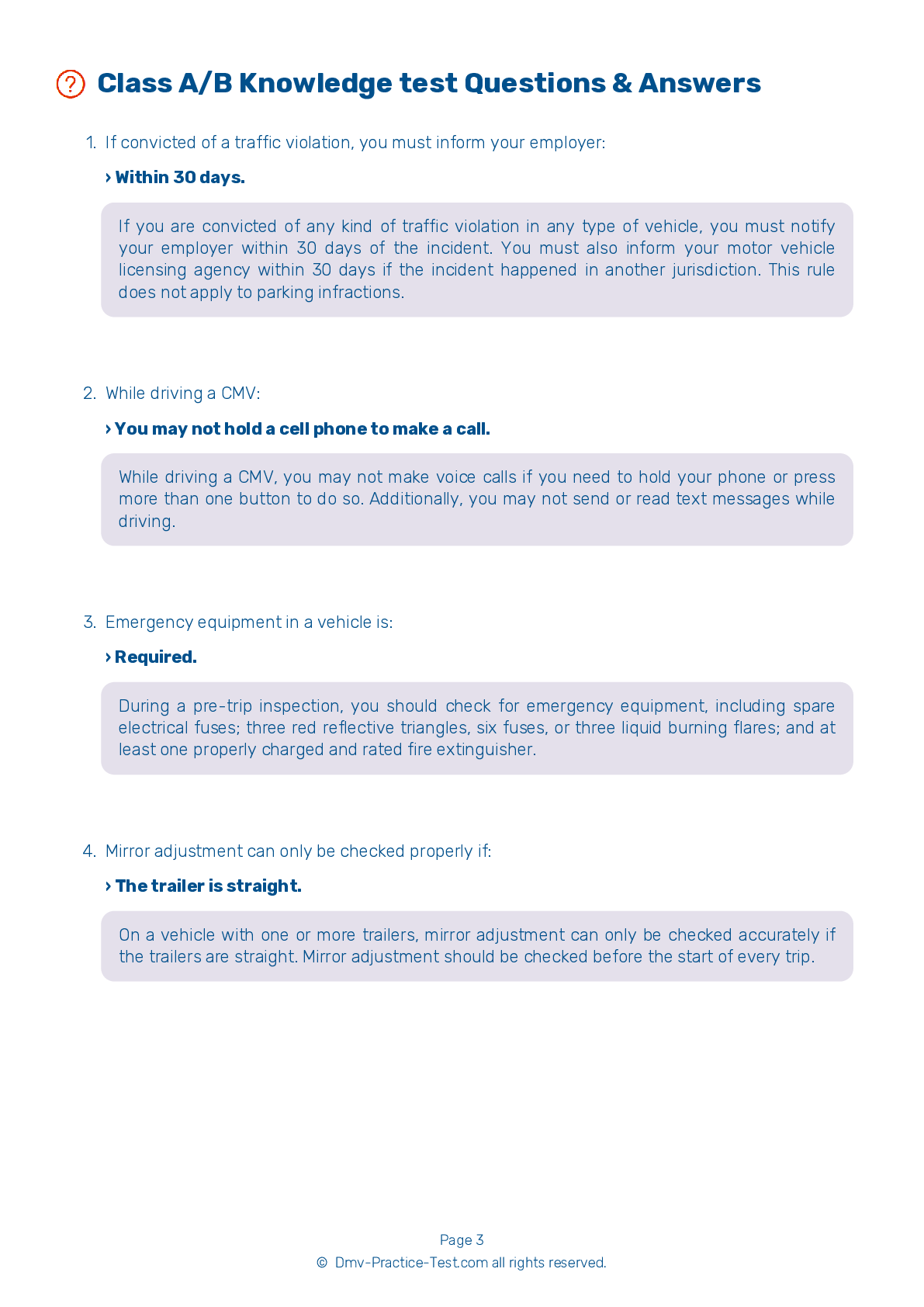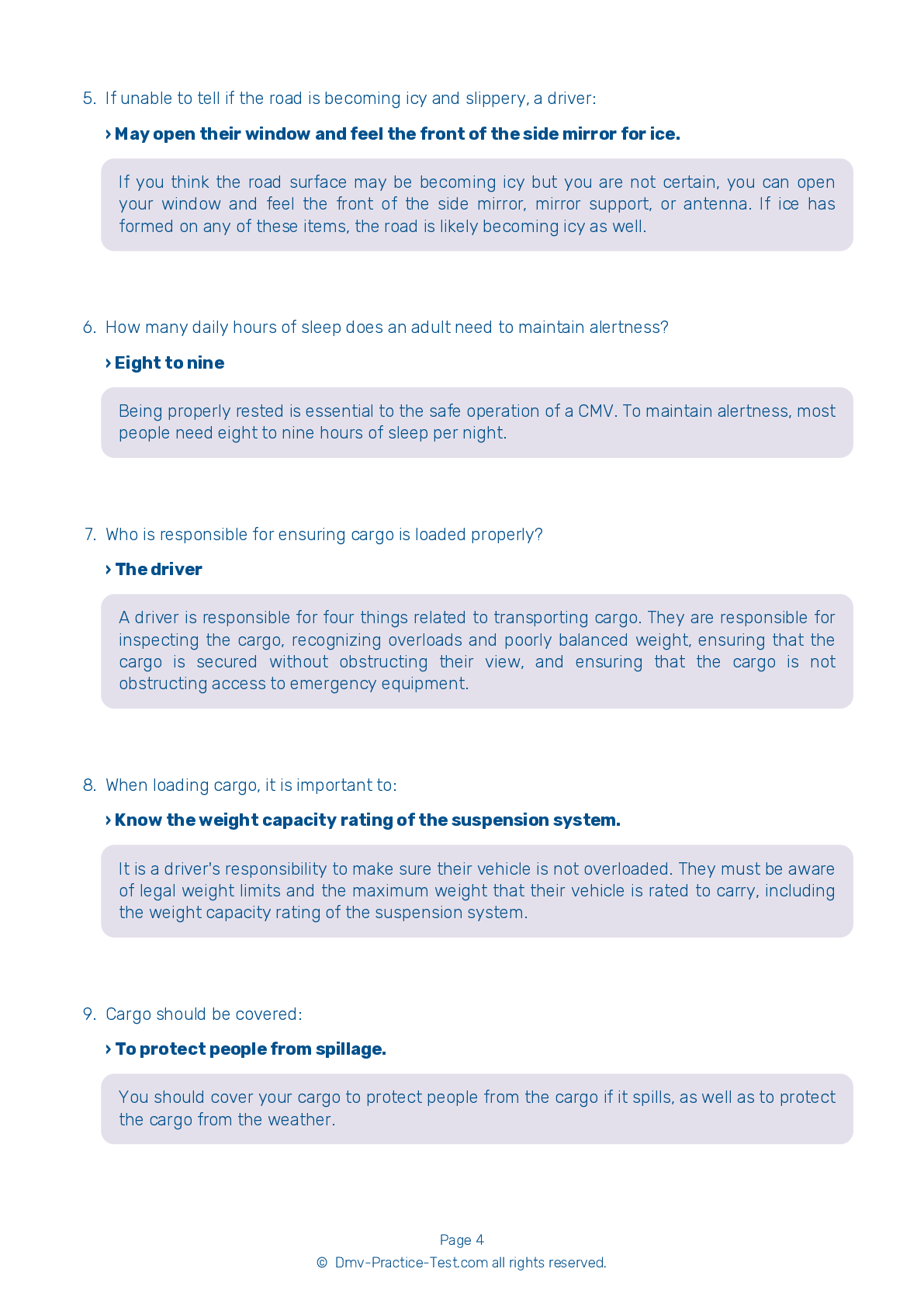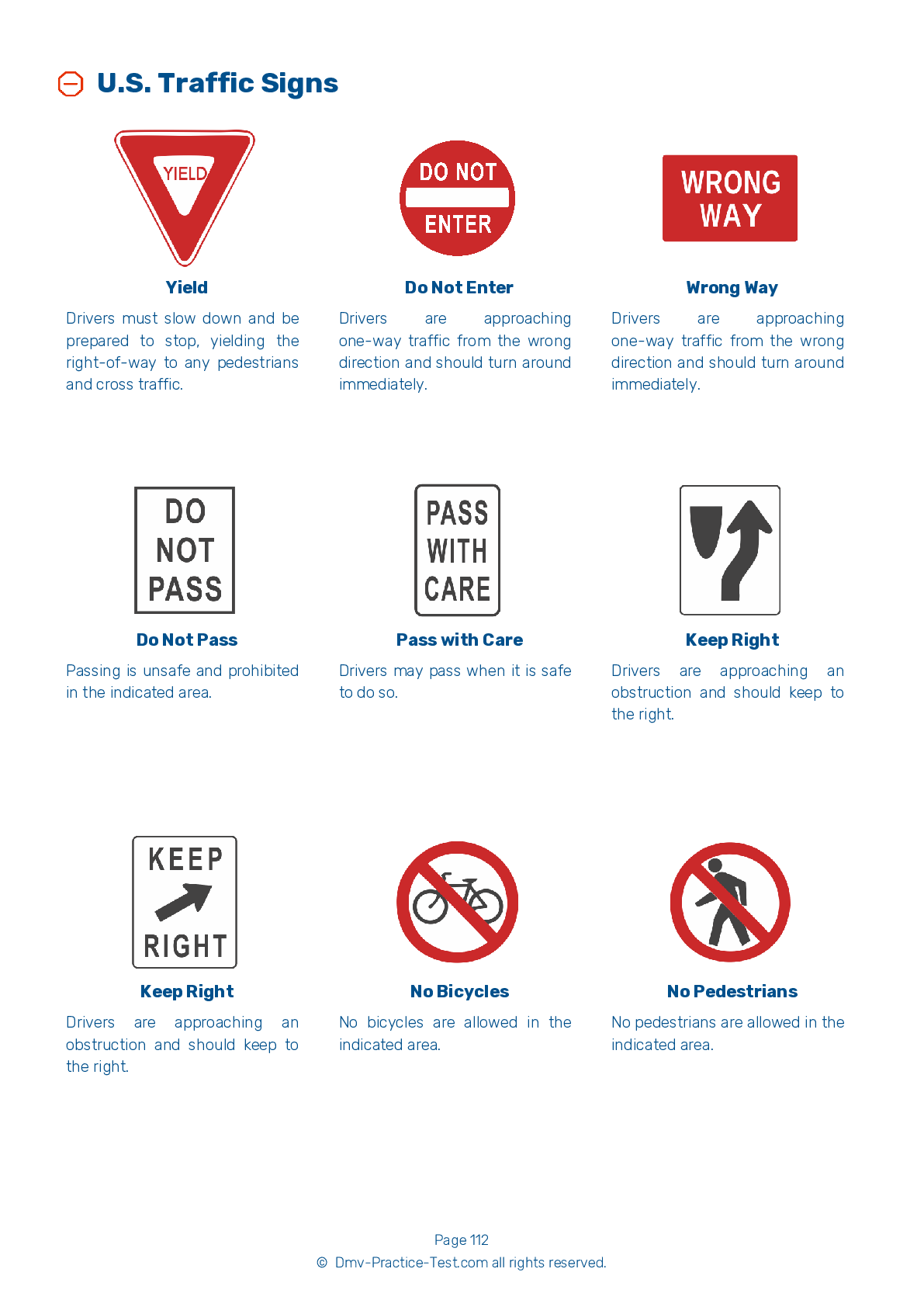Passenger #2
Passenger Endorsement | Ohio 2025 #2 Page 2 of 3
Train for FREE with our Ohio CDL passenger endorsement practice test online. The official exam test consists of several obligatory parts, with all of them checking your knowledge of different blocks of road rules. If you need to obtain a OH DMV passenger endorsement in 2025, practice as much as possible. Free sample tests published on our website will help you check and improve your knowledge and boost your grades. Please bear in mind that DMV requirements for issuing a CDL permit with passenger endorsement may vary from state to state.
20
16
20
8 . ____ is an example of required emergency equipment.
All commercial motor vehicles are required to be equipped with the proper emergency equipment. This may include spare electrical fuses; three red reflective triangles, six fuses, or three liquid burning flares; and at least one properly charged and rated fire extinguisher.
9 . If unable to tell if the road is becoming icy and slippery, a driver:
If you think the road surface may be becoming icy but you are not certain, you can open your window and feel the front of the side mirror, mirror support, or antenna. If ice has formed on any of these items, the road is likely becoming icy as well.
10 . The standee line:
On a bus designed to carry standing passengers, no passengers may stand in front of the rear of the driver's seat. Any such bus must have a line on the floor, or some other marking, that indicates where passengers may not stand. This is called a standee line.
11 . If another driver is tailgating you, you should:
If you are being tailgated, you should increase the distance between your vehicle and the vehicle ahead. This will reduce your need to make sudden moves, and will also allow the tailgater more room to pass you. Speeding up when being tailgated is not advised because it may result in the tailgater continuing to follow you closely at the higher speed, only increasing the danger.
12 . Of the following, which is the most slippery surface?
Ice becomes wet when the weather is just warm enough to melt the ice slightly. Wet ice is much more slippery than ice that is not wet.
13 . Hydroplaning usually occurs:
Hydroplaning occurs on surfaces where water has collected. If there is enough water, vehicles can hydroplane at speeds as low as 30 mph. Hydroplaning becomes more likely if tires are under-inflated or if the tread is worn.
14 . What does the vehicle inspection report do?
A vehicle inspection report keeps the carrier informed about any problems that need to be fixed.
Search the best driving school in your neighbourhood
2025 Ohio | Frequently Asked Questions
To acquire a CDL Hazmat endorsement in Ohio, first, you must hold a valid Ohio CDL. Then, pass the Hazmat knowledge test at your local BMV. You'll also need to undergo a TSA background check. Lastly, submit your application with the appropriate fees to the Ohio Bureau of Motor Vehicles (BMV). The endorsement will be added upon approval.
To obtain a CDL Hazmat license, you must have a valid Commercial Driver's License (CDL). You also need to pass the Hazardous Materials Endorsement Knowledge Test. A Transportation Security Administration (TSA) background check is required. Lastly, you must be at least 21 years old and be able to read and speak English adequately.
When applying for a CDL Hazmat endorsement in Ohio, you'll need your current Ohio CDL. You should also have proof of U.S. citizenship or legal status, such as a birth certificate, passport, or immigration documents. Additionally, you'll need to provide your Social Security number and complete a TSA security threat assessment application, which includes fingerprinting and a background check.
Yes, there is a dedicated written test for the CDL Hazmat endorsement. The Hazardous Materials Endorsement Knowledge Test is designed to evaluate your understanding of the rules and regulations of transporting hazardous materials. It covers topics such as loading and unloading, bulk packaging marking, driving and parking rules, and emergency response procedures.
The written test for the CDL Hazmat endorsement covers a variety of subjects related to hazardous materials. These include identifying different types of hazardous materials, understanding shipping papers, placarding rules, loading and unloading procedures, driving and parking rules, emergency response procedures, and how to handle hazardous materials safely and effectively.
Yes, there are additional charges associated with acquiring a CDL Hazmat endorsement in Ohio. These include fees for the knowledge test, endorsement application, fingerprinting, and background check. The exact amount may vary, so it's advised to check with the Ohio Bureau of Motor Vehicles or a local DMV office for current rates.
Yes, obtaining a CDL Hazmat endorsement requires a background check and security clearance. This is mandated by the Transportation Security Administration (TSA). The process includes fingerprinting and a check of criminal, immigration, and mental health records. The goal is to ensure that hazardous materials are transported safely and securely.
Yes, specialized training and certification are mandatory for a CDL Hazmat endorsement in Ohio. Applicants must pass a written knowledge test that covers hazardous materials regulations and safety procedures. Once you pass the test, the endorsement is added to your Commercial Driver's License. This ensures you are equipped with the necessary knowledge to handle hazardous materials.
No, you cannot legally transport hazardous materials without a valid CDL Hazmat endorsement in Ohio. The endorsement is required to ensure the driver understands the safety procedures and regulations related to transporting hazardous materials. Violating this can result in hefty fines, suspension of your CDL, or even imprisonment.
You can add a CDL Hazmat endorsement to your current CDL license without needing a new application. However, you must pass the Hazmat knowledge test and undergo a TSA background check. Once cleared, the Hazmat endorsement will be added to your existing CDL. Remember, your CDL must be valid and in good standing for this process.




